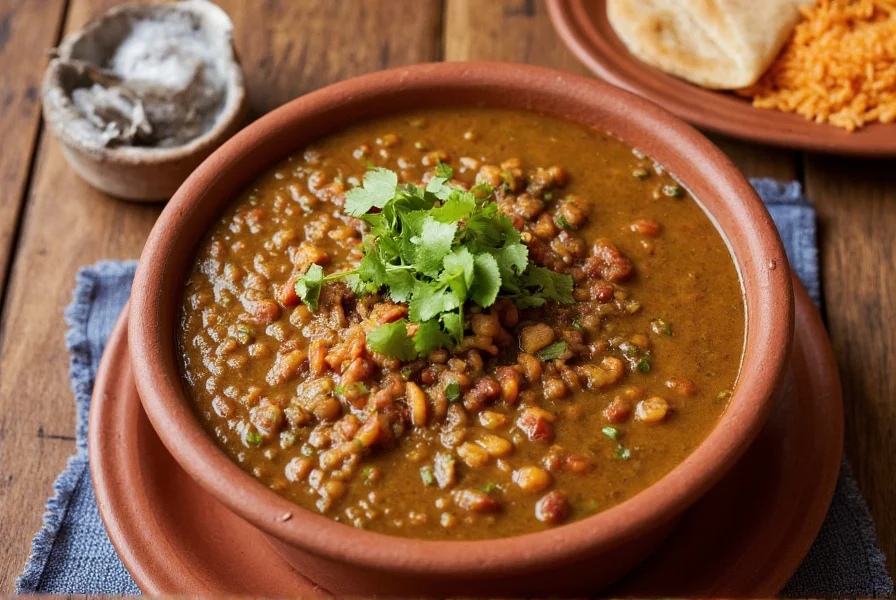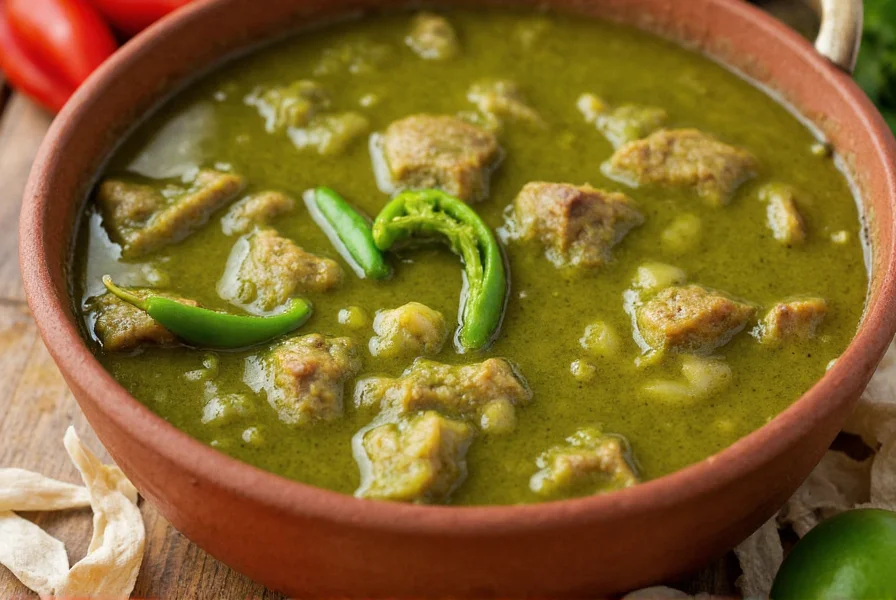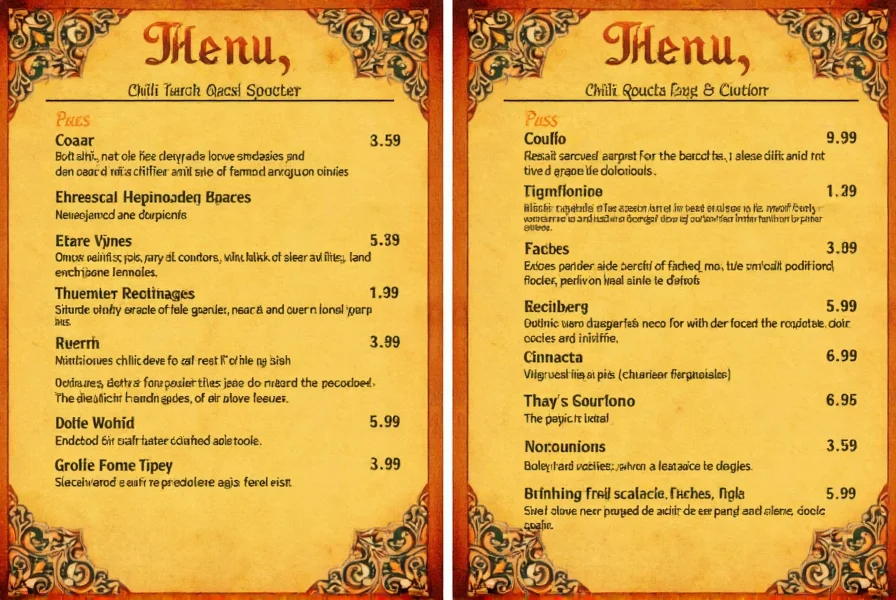Chili verde, which translates to "green chili" in Spanish, is a beloved dish with deep roots in Mexican cuisine. Unlike its red counterpart made with dried chilies, chili verde gets its vibrant color and distinctive flavor from fresh green ingredients, primarily tomatillos and serrano or jalapeño peppers. Understanding what to expect on a chili verde menu helps diners appreciate this traditional dish and make informed choices when dining at Mexican or Southwestern restaurants.
What Exactly Is Chili Verde?
Chili verde refers to both the sauce and the dish prepared with this sauce. The foundation of authentic chili verde is a cooked puree of tomatillos (small, tart, green fruits enclosed in papery husks), green chilies, onions, garlic, and cilantro. This sauce is then used as a base for simmering meat, most commonly pork shoulder or chicken, until tender. The resulting dish has a bright, tangy flavor with varying levels of heat depending on the chilies used.
Common Chili Verde Menu Items at Authentic Restaurants
When examining a traditional chili verde menu, you'll typically find several preparation styles. Here are the most common offerings you can expect:
| Menu Item | Description | Common Accompaniments |
|---|---|---|
| Chili Verde Entree | Generous portion of meat in green sauce served as a main dish | Rice, beans, tortillas, guacamole |
| Tacos de Verde | Soft corn tortillas filled with chili verde | Pico de gallo, shredded lettuce, cheese |
| Enchiladas Verdes | Corn tortillas rolled around chili verde filling, covered in sauce | Sour cream, cheese, rice |
| Chili Verde Burrito | Large flour tortilla stuffed with chili verde and extras | Rice, beans, guacamole, sour cream |
| Chili Verde Plate | Combination featuring chili verde with other menu items | Often paired with carne asada or carnitas |
Regional Variations You Might Find on a Chili Verde Menu
While the basic components remain consistent, regional differences significantly influence how chili verde appears on menus across different areas:
- Central Mexico Style: Features pork as the primary meat with a sauce emphasizing tart tomatillo flavor with moderate heat. Often includes potatoes in the preparation.
- Northern Mexico Style: Typically uses beef instead of pork, with a spicier sauce incorporating more serrano peppers.
- Tex-Mex Interpretation: May include additional ingredients like cumin or oregano not traditionally used in Mexico, and often served with yellow cheese.
- Southwestern U.S. Version: Sometimes incorporates local ingredients like New Mexico green chilies, creating a distinct regional variation.

Typical Sides and Accompaniments
No discussion of a chili verde menu would be complete without mentioning the traditional sides that complement this dish. Authentic Mexican restaurants consistently pair chili verde with:
- Mexican Rice: Also called "red rice," this tomato-infused rice provides a perfect balance to the tangy green sauce.
- Refried Beans: Usually pinto beans, either traditional or with a touch of cheese for added flavor.
- Warm Tortillas: Both corn and flour varieties, essential for scooping or making impromptu tacos.
- Condiments: Fresh pico de gallo, sliced radishes, chopped onions, and cilantro are commonly offered.
- Creamy Elements: Many menus include sour cream or crema to help moderate the heat of spicier preparations.
How Chili Verde Differs From Other Chili Menu Options
Understanding the distinctions between chili verde and other menu offerings helps diners make informed choices. While many restaurants offer both red and green chili options, the differences go beyond just color:
- Base Ingredients: Chili verde uses fresh green ingredients (tomatillos, green chilies), while red chili uses dried red chilies like ancho or guajillo.
- Flavor Profile: Chili verde has a brighter, more acidic taste from the tomatillos, whereas red chili tends to be earthier and sometimes smokier.
- Preparation Method: Traditional chili verde is often cooked with the sauce ingredients from the start, while some red chili recipes may add the chili powder later in the process.
- Regional Associations: Chili verde is particularly associated with Central Mexico, while red chili has stronger connections to Northern Mexico and Texas.
What to Expect When Ordering Chili Verde
When reviewing a chili verde menu at different types of establishments, consider these factors that might affect your experience:
- Traditional Mexican Restaurants: Likely to offer pork as the standard meat option with authentic preparation methods. May specify if chicken is available as an alternative.
- Taquerias: Often feature chili verde as a taco or burrito filling, sometimes with vegetarian options using mushrooms or nopales (cactus).
- Southwestern American Restaurants: May present more creative interpretations, potentially including unexpected ingredients or fusion elements.
- Higher-End Establishments: Might feature artisanal preparations with premium ingredients or chef's special variations on the traditional dish.

Vegetarian and Dietary Adaptations
As dietary preferences evolve, many restaurants now offer adaptations of traditional chili verde to accommodate various needs:
- Vegetarian Versions: Increasingly common, typically substituting mushrooms, potatoes, or nopales (cactus) for meat while maintaining the authentic sauce.
- Gluten-Free Options: Naturally gluten-free when served with corn tortillas instead of flour, but always verify preparation methods.
- Heat Level Adjustments: Most authentic establishments will accommodate requests for milder or spicier preparations upon request.
Conclusion: Navigating Chili Verde Menus with Confidence
Understanding what typically appears on a chili verde menu enhances your dining experience and helps you make informed choices that align with your preferences. Whether you're visiting a neighborhood taqueria or an upscale Mexican restaurant, knowing the traditional components and regional variations of this beloved dish allows you to appreciate the culinary heritage behind each preparation. When examining a menu, look for descriptions that emphasize traditional ingredients like tomatillos and specify the type of meat used, as these indicate an authentic approach to this classic dish.
Frequently Asked Questions
What is typically included in a traditional chili verde menu item?
A traditional chili verde menu item typically features slow-cooked pork or chicken in a green tomatillo-based sauce with green chilies, served with Mexican rice, refried beans, and warm tortillas. Some variations may include potatoes or other vegetables in the stew itself.
How does chili verde differ from regular red chili on restaurant menus?
Chili verde uses fresh green ingredients like tomatillos and green chilies, resulting in a brighter, more acidic flavor profile. Regular red chili uses dried red chilies, creating a deeper, earthier taste. The cooking methods and regional associations also differ significantly between these two traditional dishes.
Are vegetarian options commonly available for chili verde on menus?
Many modern Mexican and Southwestern restaurants now offer vegetarian chili verde options, typically substituting mushrooms, potatoes, or nopales (cactus) for meat while maintaining the authentic green tomatillo sauce. However, traditional preparations almost always include meat, so it's best to ask about vegetarian adaptations when ordering.
What are the most common side dishes served with chili verde?
Chili verde is traditionally served with Mexican rice (red rice), refried beans, and warm tortillas. Many restaurants also include fresh condiments like pico de gallo, sliced radishes, chopped onions, and cilantro. Sour cream or crema is often provided to help moderate the heat of spicier preparations.
How can I identify an authentic chili verde preparation on a menu?
Look for menu descriptions that specifically mention tomatillos as the base ingredient and indicate the type of meat used (typically pork shoulder or chicken). Authentic preparations won't rely on green chili powder alone but will describe a cooked sauce using fresh green ingredients. Menus from restaurants specializing in regional Mexican cuisine are more likely to offer traditional preparations.











 浙公网安备
33010002000092号
浙公网安备
33010002000092号 浙B2-20120091-4
浙B2-20120091-4